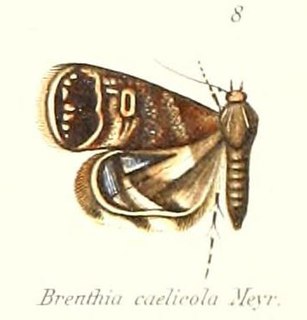Related Research Articles

Brenthia caelicola is a species of moth of the family Choreutidae. It was described by Edward Meyrick in 1910. It is found on the Kai Islands of Indonesia.
Brenthia salaconia is a species of moth of the family Choreutidae. It was described by Edward Meyrick in 1910. It is found on the Kai Islands of Indonesia.
Helcystogramma anthistis is a moth in the family Gelechiidae. It was described by Edward Meyrick in 1929. It is known from Sri Lanka.
Helcystogramma augusta is a moth in the family Gelechiidae. It was described by Edward Meyrick in 1911. It is known from north-eastern India.
Eunebristis zachroa is a moth in the family Gelechiidae. It was described by Edward Meyrick in 1914. It is found in Guyana.
Helcystogramma adaequata is a moth in the family Gelechiidae. It was described by Edward Meyrick in 1914. It is found in Guyana.
Helcystogramma gypsaspis is a moth in the family Gelechiidae. It was described by Edward Meyrick in 1921. It is found on Java in Indonesia.
Charistica callichroma is a moth in the family Gelechiidae. It was described by Edward Meyrick in 1914. It is found in Guyana and possibly Amazonas, Brazil.
Idiophantis soreuta is a moth of the family Gelechiidae. It was described by Edward Meyrick in 1906. It is found in Sri Lanka.
Polyhymno hieracitis is a species of moth of the family Gelechiidae. It was described by Edward Meyrick in 1913. It is found in South Africa (Mpumalanga).
Tisis argyrophaea is a moth in the family Lecithoceridae. It was described by Edward Meyrick in 1910. It is found on Borneo.
Tisis charadraea is a moth in the family Lecithoceridae. It was described by Edward Meyrick in 1910. It is found in Malaysia.
Tisis polemarcha is a moth in the family Lecithoceridae. It was described by Edward Meyrick in 1926. It is found on Borneo and Sabah.
Tisis helioclina is a moth in the family Lecithoceridae. It was described by Edward Meyrick in 1894. It is found in Myanmar.
Tisis mendicella is a moth in the family Lecithoceridae. It was described by Francis Walker in 1864. It is found in Sri Lanka.
Deltoplastis figurata is a moth in the family Lecithoceridae. It was described by Edward Meyrick in 1910. It is found in Sri Lanka.
Crocanthes sceletopa is a moth in the family Lecithoceridae. It was described by Edward Meyrick in 1910. It is found on the Maluku Islands in Indonesia.
Psittacastis cosmodoxa is a moth in the family Depressariidae. It was described by Edward Meyrick in 1921. It is found in Peru.

Thudaca heterastis is a moth in the family Depressariidae. It was described by Edward Meyrick in 1893. It is found in Australia, where it has been recorded from Western Australia.
Odites carcharopa is a moth in the family Depressariidae. It was described by Edward Meyrick in 1914. It is found on the Comoros in the Indian Ocean.
References
- ↑ Savela, Markku, ed. (December 31, 2014). "Tisis hemixysta Meyrick, 1910". Lepidoptera and Some Other Life Forms. Retrieved September 12, 2020.
- ↑ Transactions of the Entomological Society of London. 1910: 438.
| This article relating to the subfamily Lecithocerinae is a stub. You can help Wikipedia by expanding it. |